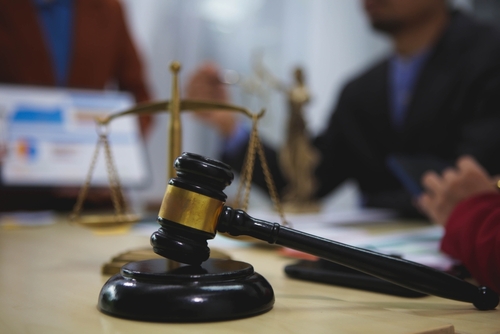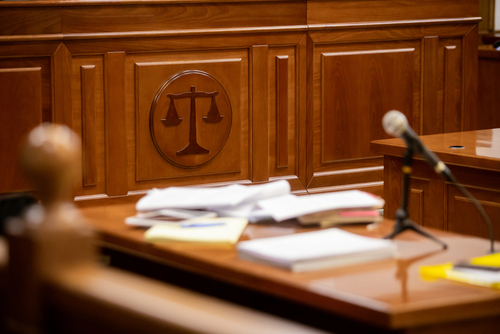After an examination for discovery, your personal injury case enters a significant phase of analysis and strategy. Your lawyer will review the sworn testimony, assess the strengths and weaknesses it revealed, and use this information to determine the most effective next steps. Edmonton personal injury lawyers often use this period to make strategic decisions about gathering further evidence, engaging in settlement negotiations, and preparing for the possibility of a trial.
It is common to feel a sense of uncertainty after being questioned under oath. You may be wondering what the other side thinks of your testimony and how it impacts your claim.
If you have questions about what comes next in your personal injury case, you deserve to get clear answers. Contact MNH Injury Lawyers for a straightforward conversation about your situation at (888) 664-5298.
What is an Examination for Discovery?

An examination for discovery is a formal pre-trial procedure where parties to a lawsuit are questioned under oath by the opposing party’s lawyer.
According to the Canadian Nurses Protective Society, “examinations for discovery are a pre-trial proceeding which permits any party to a civil lawsuit to obtain information about the case of any party who is adverse in interest to him.” This process is governed by the Alberta Rules of Court and overseen by the Court of King’s Bench of Alberta.
The Purpose and Process
The examination serves several functions in the litigation process. As outlined by legal authorities, examinations for discovery allow lawyers to “understand the nature of the other side’s case; obtain a preview of the documentary evidence; gain admissions for use at trial; commit an opposing witness to their testimony; fix and narrow the matters really in issue in the litigation; and gather information to facilitate settlement.”
During the examination, you will be questioned under oath in the presence of a court reporter who creates a written transcript of everything said. Unlike a trial, no judge is present, but the sworn testimony can be used as evidence if the case proceeds to court. Under Alberta’s Rules of Court, “a person is required to answer only relevant and material questions” that could reasonably be expected to “significantly help determine one or more of the issues raised in the pleadings.” This stage underscores why knowing how to choose a personal injury lawyer is so important, since skilled guidance can shape how your testimony is presented and later used.
Why This Stage Matters
The examination for discovery represents a turning point in personal injury cases. It provides both sides with a clearer picture of the strengths and weaknesses of their respective positions, which frequently leads to more productive settlement negotiations.
What is the First Thing That Happens After an Examination for Discovery?
Once your examination for discovery is complete, the focus shifts from giving testimony to analyzing it. This stage is methodical and sets the groundwork for all subsequent actions in your lawsuit. It begins with a careful review of the official record and a deep dive into what the testimony means for your case moving forward.
The Transcript Review
The first tangible step is waiting for the court reporter to produce a written transcript of everything said during the examination for discovery. This usually takes a few weeks. This document is a precise, word-for-word record of the questions you were asked and the answers you provided under oath. At this point, many clients wonder how can a lawyer help, and the answer is that your lawyer will carefully review the transcript to confirm accuracy and to shape the next steps in building a stronger case.
Our team meticulously reviews this transcript for accuracy. It is important that the record correctly reflects what was said. We also analyze the testimony given by the person or people you are suing (the defendant). Their statements, made under oath, are now locked in, which prevents them from changing their story later at trial.
Strategic Case Analysis
With the transcripts in hand, we conduct a comprehensive analysis of the case. The examination for discovery provides a clear picture of how you present as a witness and the strength of your memory and statements. It also gives us valuable insight into the defence’s likely arguments and how they may try to challenge your claim.
Based on this new information, we refine our legal strategy. This might involve focusing on certain pieces of evidence that now carry more weight or preparing to counter the specific tactics we anticipate from the defence. This analysis helps to position your case as strongly as possible for the next phases, and it is a good time to contact a lawyer to make sure your rights and interests are fully protected moving forward.
Will There Be More Medical Examinations?
After your testimony has been recorded, the defence will want to gather its own evidence about your physical condition. This might involve a request for an additional medical assessment to get an independent view of your injuries.
The Role of Independent Medical Examinations (IMEs)
It is common for the defence’s legal team to request that you attend an Independent Medical Examination, or IME, after the examination for discovery. An IME is a medical assessment performed by a healthcare practitioner who has not previously treated you. The purpose is for the defence’s chosen medical professional to provide a third-party opinion on your injuries, their severity, and your prognosis for recovery.
While the defence chooses the doctor, that practitioner is still bound by professional ethics to provide an objective assessment. This examination is not for treatment purposes; it is purely for evaluation. The resulting report is a formal piece of evidence that both sides will use to argue the extent of your injuries and their impact on your life.
How Do We Prepare You for an IME?
We make sure you understand the purpose of the examination and what to expect. We will guide you on how to describe your injuries and their effect on your life honestly and accurately, without offering information that is not requested.
The goal is to provide the examiner with the necessary information to form an opinion, but to do so in a clear and direct manner.
Does a Settlement Happen Soon After an Examination for Discovery?
With sworn testimony from both sides on the record, the strengths and weaknesses of each case become much clearer, paving the way for more productive negotiations.
The Negotiation Phase is Reignited
Examinations for discovery often trigger a new round of settlement negotiations. With the evidence clearer and each side having a better sense of the other’s case, both parties are in a more informed position to discuss a resolution. The defence lawyer will report back to the insurance company about your testimony and how you presented as a witness, which often influences the type of settlement offer in Alberta you may receive.
A strong, consistent, and credible performance during your examination for discovery could lead to a more reasonable settlement offer.
What is Mediation and Will it Happen in My Case?
If direct negotiations do not result in a fair settlement, the next step may be mediation. In Alberta, mediation is available as an alternative dispute resolution process, though it is not automatically mandatory for all personal injury cases. The court may direct parties to attend mediation, or parties may voluntarily choose to participate in this process.
- How Mediation Works: Mediation is a structured negotiation session facilitated by a neutral third-party called a mediator. The mediator’s job is not to make a decision, but to help both sides find common ground and reach a voluntary agreement.
- The Process: It typically involves opening statements from both lawyers, followed by a series of private discussions between the mediator and each party. Offers and counter-offers are passed back and forth through the mediator, who works to bridge the gap between the two positions.
- The Benefit: Mediation is a confidential, less formal, and less expensive process than a trial. It provides a valuable opportunity to resolve the case while giving you more control over the final outcome, as any settlement must be voluntarily agreed upon by you.
What if My Case Doesn’t Settle? Preparing for Trial

While the vast majority of personal injury cases settle before reaching a courtroom, we always prepare as if a trial is a certainty. This approach ensures that we are ready for any outcome and that your case is positioned for strength, whether in negotiation or in front of a judge, giving you confidence throughout the Alberta claims process.
Finalizing Evidence and Witnesses
If a settlement is not reached through negotiation or mediation, our focus shifts to finalizing all trial preparations. This involves organizing all the evidence that will be presented, including:
- Medical reports and records detailing your injuries.
- Opinions from medical and financial experts.
- Financial documents showing lost income and other expenses.
We also finalize our witness list. This involves identifying which experts, such as doctors or economists, will testify to explain complex aspects of your case. It also includes preparing any laypersons, like family members or colleagues, who can speak to how the injuries have impacted your daily life.
Pre-Trial Conferences
Before a trial date is set, the court will typically hold a pre-trial conference. This is a meeting with a judge to discuss the primary issues of the case, ensure all procedural matters are handled, and make one final attempt to see if a settlement can be reached with the judge’s input. It serves to streamline the trial process by narrowing down the contested issues.
What Does a Trial Involve?
A trial follows a structured format designed to allow both sides to present their case to a decision-maker—either a judge alone or a judge and jury. Many clients wonder what is a good settlement offer, and part of trial preparation is comparing potential trial outcomes with offers already made to decide the best path forward.
- Opening Statements: Both lawyers present a roadmap of their case.
- Presenting Evidence: We present your case first by calling witnesses to testify and submitting documents and other evidence. The defence has the opportunity to cross-examine our witnesses.
- The Defence’s Case: The defence then presents its evidence and witnesses, and we have the right to cross-examine them.
- Closing Arguments: Each side summarizes their evidence and argues why the decision should be in their favour.
- The Verdict: The judge or jury will then deliberate and make a final decision on the case, determining liability and the amount of compensation, if any.
Frequently Asked Questions About the Post-Examination for Discovery Process
How long does a personal injury lawsuit take after the examination for discovery?
The timeline varies significantly. After the examination for discovery, subsequent steps like settlement negotiations, mediation, and potential trial preparation can add several more months or even years. The final duration depends on the complexity of your case, the willingness of the other side to negotiate, and the schedule of the courts.
Can I do anything to help my case at this stage?
Yes. The most important things you can do are to continue with your prescribed medical treatments and follow your doctor’s advice. Keep detailed records of your expenses and the ways your injuries continue to affect your daily life. It is also important to communicate any changes in your condition or new medical appointments to our office promptly so we can keep your file current.
What happens if the defence finds conflicting information after my examination for discovery?
The defence will use any inconsistencies to challenge your credibility. This is why thorough preparation before the examination for discovery is so important. If new or conflicting information arises, we will address it strategically. This may involve providing clarifying information to the defence or preparing to confront the issue head-on at trial with a clear explanation.
Is it a bad sign if the insurance company’s offer doesn’t increase after the examination for discovery?
Not necessarily. An initial offer may remain firm as a negotiating tactic. The examination for discovery is just one of many factors that influence a final settlement. Sometimes, expert reports that are finalized after examinations for discovery, or the discussions that happen during mediation, play a more significant role in changing a settlement offer.
Will I have to testify in court if my case goes to trial?
Yes, if your case proceeds to trial, you will be required to testify. Your testimony is a central part of presenting your case to the judge or jury. We will prepare you thoroughly for this, just as we did for the examination for discovery. You will understand the process, the types of questions to expect, and how to present your story clearly and effectively, as well as what evidence should I collect to strengthen your case and support your testimony.
Clarity and Confidence on the Path Forward

The phase after your examination for discovery is where the direction of your case is truly set. It is a period of intense legal work, strategic negotiation, and diligent preparation. You do not have to face this uncertainty alone. Let our experience guide you through these important steps.
If you need to discuss the next steps in your personal injury claim, call MNH Injury Lawyers today at (888) 664-5298 for the clarity you need.
